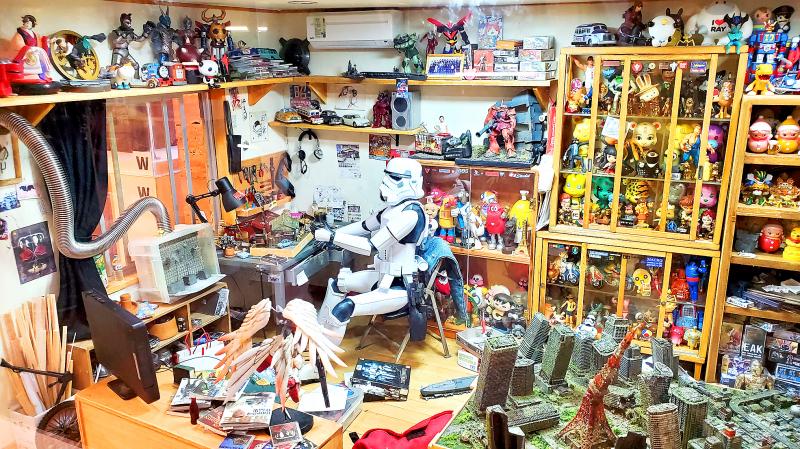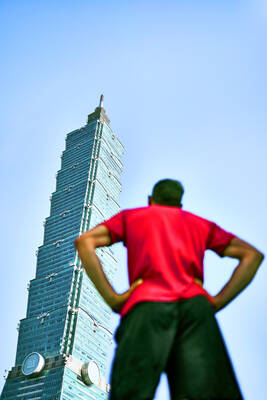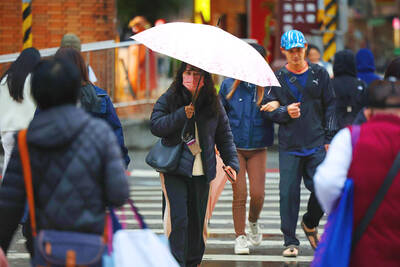From a bucolic rural grocery shop to fictional battlefields and robot warrior bases, artisans are meticulously handcrafting miniature worlds that fuse reality and fantasy.
When he is not designing interiors, 51-year-old Hank Cheng (鄭鴻展) can usually be found in his studio conjuring tiny but intricately detailed scenes.
“I like to try to make anything, whether it’s clean, old or dirty, to let my imagination run wild,” he said.

Photo: Chang Chung-yi, Taipei Times
His creations range from a replica of a 40-year-old grocery store in central Taiwan that caught his eye, to an imaginary “secret maintenance base” for a legion of Minions made from a discarded Minion-shaped cookie box he recycled.
“When people ask me is there anything I can’t make, I joke: ‘Only air and sunshine,’” Cheng said.
In his youth, Cheng studied illustrations in Japan, where miniatures and dioramas have long been popular.
He only started making miniatures himself five years ago after spotting a photograph of a Japanese artist’s work that was so realistic he thought it was real at first sight.
Recycling is a recurring theme for Cheng, who was raised to cherish finite resources in a thrifty family.
One of his most detailed pieces is a painstakingly accurate model of an old Japanese restaurant selling eel rice dishes — complete with smoke-stained kitchen and greased floor — which won awards at a Japanese competition.
Another favorite design is a run-down bar with rowdy patrons, graffitied walls and a back alley littered with garbage so realistic that Cheng hopes viewers can “smell the odor” just by looking at it.
“I hope each of my creations tells a story to get people interested, and it does not just look pretty or look realistic,” said Cheng, who has also published a book on making miniatures and held solo exhibitions.
“I hope it shows some ‘warmth’ and the traces of real things,” he said.
Hikari Yang, 39, started making miniatures at a time in her life when she was feeling low.
She recalled that by the time she completed her first work — a Japanese-styled town of her dreams — she felt “healed” by the process and had forgotten about her troubles.
She set up the FM Dioramas studio in Taoyuan in late 2016 with several partners, maintaining a day job until she was recently able to switch to making models full time.
The group’s portfolio is filled with detailed models featuring real-life or sci-fi scenes that on average take eight to nine months to complete.
Her studio has cultivated a following by giving miniature-making classes across Taiwan and it also creates miniature items that are shipped to fellow modelers around the world.
“People come to our classes to learn to make what we call ‘healing little items’ like a tree in a park. Making the miniature from scratch provides a release of the stress in their busy lives,” Yang said.
Her partner, Chen Shih-jen, 45, said that building dioramas helps take the edge off his full-time computer programming job.
Commissions are varied. One custom order Chen received from a government agency was to recreate a miniature traditional Sediq home.
Another came from a couple who wanted a model of the restaurant they had their first date in.
A more elaborate diorama he built for his own collection contains an environmental message. The futuristic gas station — servicing flying cars in a world where rising oceans have swallowed the land — won a prize in Hungary.
“The work depicts how people would live when the land disappears,” he said. “Climate change and global warming are happening right now and I hope people will cherish the present. What we see as normal resources are limited and could be gone one day.”

US climber Alex Honnold is to attempt to scale Taipei 101 without a rope and harness in a live Netflix special on Jan. 24, the streaming platform announced on Wednesday. Accounting for the time difference, the two-hour broadcast of Honnold’s climb, called Skyscraper Live, is to air on Jan. 23 in the US, Netflix said in a statement. Honnold, 40, was the first person ever to free solo climb the 900m El Capitan rock formation in Yosemite National Park — a feat that was recorded and later made into the 2018 documentary film Free Solo. Netflix previewed Skyscraper Live in October, after videos

Starting on Jan. 1, YouBike riders must have insurance to use the service, and a six-month trial of NT$5 coupons under certain conditions would be implemented to balance bike shortages, a joint statement from transportation departments across Taipei, New Taipei City and Taoyuan announced yesterday. The rental bike system operator said that coupons would be offered to riders to rent bikes from full stations, for riders who take out an electric-assisted bike from a full station, and for riders who return a bike to an empty station. All riders with YouBike accounts are automatically eligible for the program, and each membership account

NUMBERS IMBALANCE: More than 4 million Taiwanese have visited China this year, while only about half a million Chinese have visited here Beijing has yet to respond to Taiwan’s requests for negotiation over matters related to the recovery of cross-strait tourism, the Tourism Administration said yesterday. Taiwan’s tourism authority issued the statement after Chinese-language daily the China Times reported yesterday that the government’s policy of banning group tours to China does not stop Taiwanese from visiting the country. As of October, more than 4.2 million had traveled to China this year, exceeding last year. Beijing estimated the number of Taiwanese tourists in China could reach 4.5 million this year. By contrast, only 500,000 Chinese tourists are expected in Taiwan, the report said. The report

Temperatures are forecast to drop steadily as a continental cold air mass moves across Taiwan, with some areas also likely to see heavy rainfall, the Central Weather Administration (CWA) said. From today through early tomorrow, a cold air mass would keep temperatures low across central and northern Taiwan, and the eastern half of Taiwan proper, with isolated brief showers forecast along Keelung’s north coast, Taipei and New Taipei City’s mountainous areas and eastern Taiwan, it said. Lows of 11°C to 15°C are forecast in central and northern Taiwan, Yilan County, and the outlying Kinmen and Lienchiang (Matsu) counties, and 14°C to 17°C